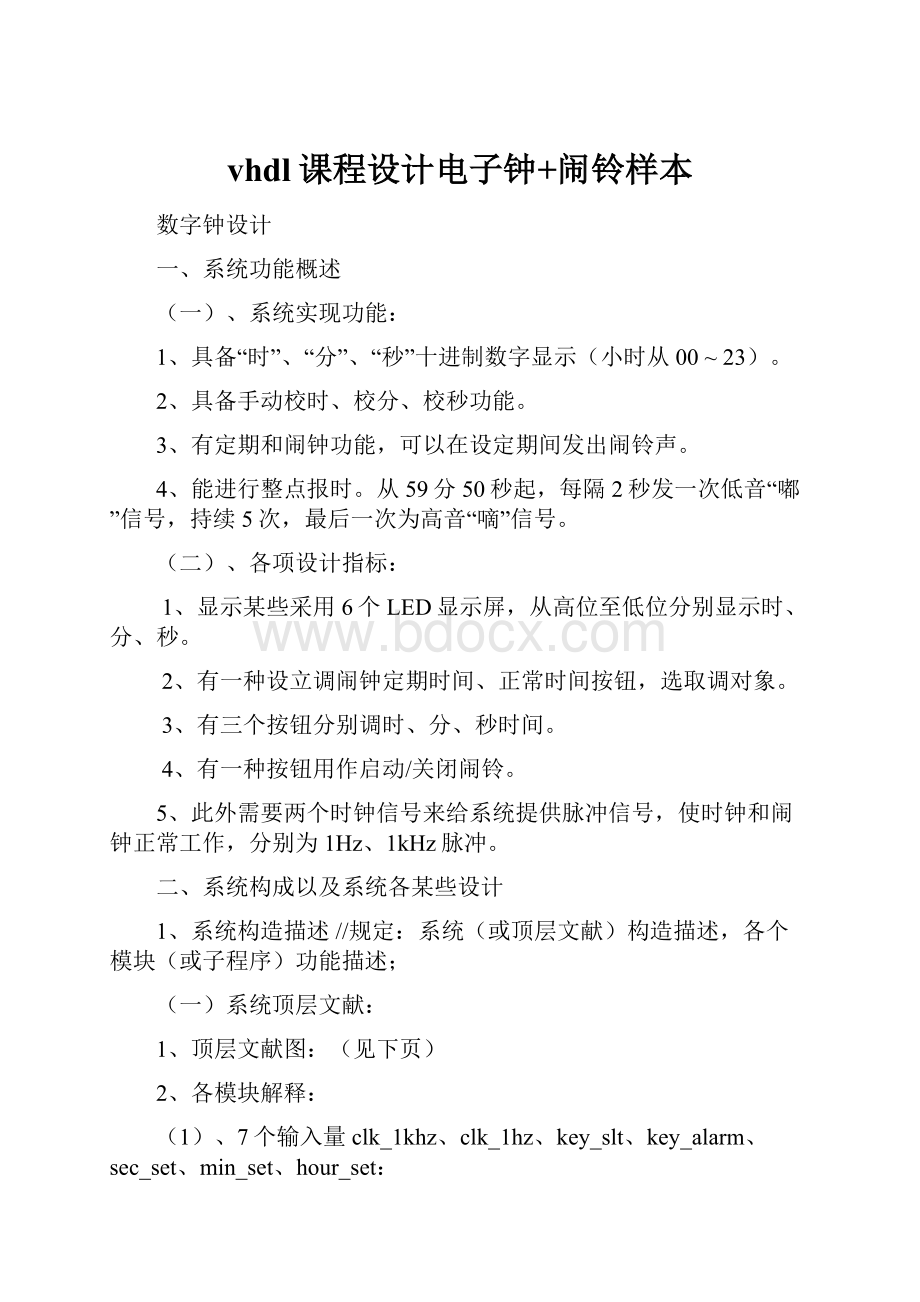vhdl课程设计电子钟+闹铃样本.docx
《vhdl课程设计电子钟+闹铃样本.docx》由会员分享,可在线阅读,更多相关《vhdl课程设计电子钟+闹铃样本.docx(24页珍藏版)》请在冰豆网上搜索。

vhdl课程设计电子钟+闹铃样本
数字钟设计
一、系统功能概述
(一)、系统实现功能:
1、具备“时”、“分”、“秒”十进制数字显示(小时从00~23)。
2、具备手动校时、校分、校秒功能。
3、有定期和闹钟功能,可以在设定期间发出闹铃声。
4、能进行整点报时。
从59分50秒起,每隔2秒发一次低音“嘟”信号,持续5次,最后一次为高音“嘀”信号。
(二)、各项设计指标:
1、显示某些采用6个LED显示屏,从高位至低位分别显示时、分、秒。
2、有一种设立调闹钟定期时间、正常时间按钮,选取调对象。
3、有三个按钮分别调时、分、秒时间。
4、有一种按钮用作启动/关闭闹铃。
5、此外需要两个时钟信号来给系统提供脉冲信号,使时钟和闹钟正常工作,分别为1Hz、1kHz脉冲。
二、系统构成以及系统各某些设计
1、系统构造描述//规定:
系统(或顶层文献)构造描述,各个模块(或子程序)功能描述;
(一)系统顶层文献:
1、顶层文献图:
(见下页)
2、各模块解释:
(1)、7个输入量clk_1khz、clk_1hz、key_slt、key_alarm、sec_set、min_set、hour_set:
其中clk_1khz为闹铃模块提供时钟,解决后能产生“嘟”、“嘀”和变化闹铃声音;clk_1hz为计时模块提供时钟信号,每秒计数一次;key_slt选取设立对象:
定期或正常时间;key_alarm可以启动和关闭闹铃;sec_set、min_set、hour_set用于设立时间或定期,与key_slt有关联。
各按键输出为脉冲信号。
(2)、CNT60_A_SEC模块:
这个模块式将clk_1hz这个时钟信号进行60进制计数,并产生一种分钟触发信号。
该模块能将当前计数值实时按BCD码格式输出。
将该输出接到两位LED数码后能时时显示秒状态。
通过alarm_clk可以选取设立对象为时间还是定期值。
在设立时间模式上,key上一种输入脉冲可以将clk输入信号加一。
在设立定期模式上,key上脉冲只修改定期值,不影响时间脉冲clk状态。
同步该模块具备两个输出口out_do、out_di来触发整点报时“嘟”、“嘀”声音。
(3)、CNT60_A_MIN模块:
这个模块式将CNT60_A_SEC输出信号进行60进制计数,并产生一种时位触发信号。
该模块能将当前计数值实时按BCD码格式输出。
将该输出接到两位LED数码后能时时显示分状态。
通过alarm_clk可以选取设立对象为时间还是定期值。
在设立时间模式上,key上一种输入脉冲可以将clk输入信号加一。
在设立定期模式上,key上脉冲只修改定期值,不影响时间脉冲clk状态。
同步该模块具备三个输出口out_do、out_di、out_alarm来触发整点报时“嘟”、“嘀”、闹铃声音。
(4)、CNT24_A_HOUR模块:
这个模块式将CNT60_A_MIN输出信号做24进制计数。
该模块能将当前计数值实时按BCD码格式输出。
将该输出接到两位LED数码后能时时显示时状态。
通过alarm_clk可以选取设立对象为时间还是定期值。
在设立时间模式上,key上一种输入脉冲可以将clk输入信号加一。
在设立定期模式上,key上脉冲只修改定期值,不影响时间脉冲clk状态。
同步该模块具备一种输出口out_alarm来触发整点报时闹铃声音。
(5)、PWM_OUT模块:
该模块为PWM产生模块,通过EN可启动和关闭PWM输出。
模块依照CLK信号二分频产生高低音,并组合,能输出三种声音状态——“嘟”、“嘀”、闹铃。
而该三种声音要被秒、分、时输出触发才干输出PWM。
(二)系统各个模块VHDL程序:
(1)、CNT60_A_SEC模块:
程序源代码如下:
libraryieee;
useieee.std_logic_1164.all;
useieee.std_logic_unsigned.all;
entitycnt60_a_secis
port(
clk,clr,enb:
instd_logic;--clk:
时钟输入信号,clr:
清零端,enb:
使能端
key:
instd_logic;--输入按键脉冲,调节闹铃定期或时间
alarm_clk:
instd_logic;--1:
alarm0:
clk--设立模式选取:
闹铃调节模式、时间调节模式
qout_sl:
outstd_logic_vector(3downto0);--显示输出秒低位
qout_sh:
outstd_logic_vector(3downto0);--显示输出秒高位
co:
outstd_logic;--进位输出,触发分计数模块
out_do:
outstd_logic;--在整点报时中输出“嘟”触发信号
out_di:
outstd_logic--在整点报时中输出“嘀”触发信号
);
end;
architectureaofcnt60_a_secis
signalqout2_l:
std_logic_vector(3downto0);
signalqout2_h:
std_logic_vector(3downto0);
signalalarm_l:
std_logic_vector(3downto0);
signalalarm_h:
std_logic_vector(3downto0);
signalclk1,clk2,tclk,aclk,ac_slt:
std_logic;
begin
process(alarm_clk)--当该端口输入一种脉冲时,修改设立模式:
时间调节或闹铃模式切换
begin
ifalarm_clk'eventandalarm_clk='1'then
ifac_slt='0'then--如果为定期模式,将改为闹铃模式
ac_slt<='1';
else
ac_slt<='0';
endif;
endif;
endprocess;
process(key,clk,ac_slt)--依照设立模式,解决key上脉冲信号
begin
ifac_slt='0'then--时间调节模式
aclk<='0';
ifclk='1'andkey='1'then--clk=1则tclk<=0,通过挖洞方式添加一种脉冲
tclk<='0';
elsifclk='0'andkey='1'then--clk=0,则tclk<=1,产生一种高电平,添加一脉冲
tclk<='1';
else
tclk<=clk;
endif;
elsifac_slt='1'then--闹铃调节模式
tclk<=clk;
aclk<=key;--key上脉冲直接修改闹铃定期值
endif;
endprocess;
process(tclk,clr,enb)--60进制计数,个位、十位放在两个暂时变量中,表达秒状态
begin
ifclr='1'then--clearingworksatthestateofhighvoltage
qout2_l<="0000";
qout2_h<="0000";
elsiftclk'eventandtclk='1'then
ifenb='1'then--enableworksathighvoltage
ifqout2_l="1001"andqout2_h="0101"then
qout2_l<="0000";--afullmodeiscompletedandacarryoutisgenerated
qout2_h<="0000";
elsifqout2_l="1001"then
qout2_l<="0000";
qout2_h<=qout2_h+1;
else
qout2_l<=qout2_l+1;--inprocessofcounting
endif;
endif;
endif;
endprocess;
process(aclk,clr,enb)--修改闹铃定期值
begin
ifclr='1'then--clearingworksatthestateofhighvoltage
alarm_l<="0000";
alarm_h<="0000";
elsifaclk'eventandaclk='1'then
ifenb='1'then--enableworksathighvoltage
ifalarm_l="1001"andalarm_h="0101"then
alarm_l<="0000";--afullmodeiscompletedandacarryoutisgenerated
alarm_h<="0000";
elsifalarm_l="0101"then
alarm_l<="0000";
alarm_h<=alarm_h+1;
else
alarm_l<=alarm_l+1;--inprocessofcounting
endif;
endif;
endif;
endprocess;
process(qout2_l,qout2_h,alarm_l,alarm_h,alarm_clk)--产生进位,显示时间或闹铃定期值
begin
ifqout2_l="0000"andqout2_h="0000"then
co<='1';
else
co<='0';
endif;
ifac_slt='0'then--显示时间
qout_sl<=qout2_l;
qout_sh<=qout2_h;
else--显示定期值
qout_sh<=alarm_h;
qout_sl<=alarm_l;
endif;
endprocess;
process(qout2_l,qout2_h)--依照秒状态输出“嘟”、“嘀”触发信号
begin
ifqout2_h="0101"then
ifqout2_l="0000"then
out_do<='1';
elsifqout2_l="0010"then
out_do<='1';
elsifqout2_l="0100"then
out_do<='1';
elsifqout2_l="0110"then
out_do<='1';
elsifqout2_l="1000"then
out_do<='1';
else
out_do<='0';
endif;
elsifqout2_h="0000"then
ifqout2_l="0000"then
out_di<='1';
out_do<='0';
else
out_di<='0';
endif;
else
out_do<='0';
out_di<='0';
endif;
endprocess;
end;
(2)、CNT60_A_MIN模块:
libraryieee;
useieee.std_logic_1164.all;
useieee.std_logic_unsigned.all;
entitycnt60_a_minis
port(
clk,clr,enb:
instd_logic;--clk:
时钟输入信号,clr:
清零端,enb:
使能端
key:
instd_logic;--输入按键脉冲,调节闹铃定期或时间
alarm_clk:
instd_logic;--1:
alarm0:
clk--设立模式选取:
闹铃调节模式、时间调节模式
qout_ml:
outstd_logic_vector(3downto0);--显示输出分低位
qout_mh:
outstd_logic_vector(3downto0);--显示输出分高位
co:
outstd_logic;--进位输出,触发时计数模块
out_alarm:
outstd_logic;--闹铃触发信号,时间到后输出高电平触发闹铃
out_do,out_di:
outstd_logic--在整点报时中输出“嘟”“嘀”触发信号
);
end;
architectureaofcnt60_a_minis
signalqout2_l:
std_logic_vector(3downto0);
signalqout2_h:
std_logic_vector(3downto0);
signalalarm_l:
std_logic_vector(3downto0);
signalalarm_h:
std_logic_vector(3downto0);
signalclk1,clk2,tclk,aclk,ac_slt:
std_logic;
begin
process(alarm_clk)--当该端口输入一种脉冲时,修改设立模式:
时间调节或闹铃模式切换
begin
ifalarm_clk'eventandalarm_clk='1'then
ifac_slt='0'then--如果为定期模式,将改为闹铃模式
ac_slt<='1';
else
ac_slt<='0';
endif;
endif;
endprocess;
process(key,clk,ac_slt)--依照设立模式,解决key上脉冲信号
begin
ifac_slt='0'then--时间调节模式
aclk<='0';
ifclk='1'andkey='1'then--clk=1则tclk<=0,通过挖洞方式添加一种脉冲
tclk<='0';
elsifclk='0'andkey='1'then--clk=0,则tclk<=1,产生一种高电平,添加一脉冲
tclk<='1';
else
tclk<=clk;
endif;
elsifac_slt='1'then--闹铃调节模式
tclk<=clk;
aclk<=key;--key上脉冲直接修改闹铃定期值
endif;
endprocess;
process(tclk,clr,enb)--60进制计数,个位、十位放在两个暂时变量中,表达分状态
begin
ifclr='1'then--clearingworksatthestateofhighvoltage
qout2_l<="0000";
qout2_h<="0000";
elsiftclk'eventandtclk='1'then
ifenb='1'then--enableworksathighvoltage
ifqout2_l="1001"andqout2_h="0101"then
qout2_l<="0000";--afullmodeiscompletedandacarryoutisgenerated
qout2_h<="0000";
elsifqout2_l="1001"then
qout2_l<="0000";
qout2_h<=qout2_h+1;
else
qout2_l<=qout2_l+1;--inprocessofcounting
endif;
endif;
endif;
endprocess;
process(aclk,clr,enb)--修改闹铃定期值
begin
ifclr='1'then--clearingworksatthestateofhighvoltage
alarm_l<="0000";
alarm_h<="0000";
elsifaclk'eventandaclk='1'then
ifenb='1'then--enableworksathighvoltage
ifalarm_l="1001"andalarm_h="0101"then
alarm_l<="0000";--afullmodeiscompletedandacarryoutisgenerated
alarm_h<="0000";
elsifalarm_l="0101"then
alarm_l<="0000";
alarm_h<=alarm_h+1;
else
alarm_l<=alarm_l+1;--inprocessofcounting
endif;
endif;
endif;
endprocess;
process(qout2_l,qout2_h,alarm_l,alarm_h,alarm_clk)--产生进位,显示时间或闹铃定期值ofhighvoltage
begin
ifqout2_l="0000"andqout2_h="0000"then
co<='1';
else
co<='0';
endif;
ifac_slt='0'then
qout_ml<=qout2_l;
qout_mh<=qout2_h;
else
qout_mh<=alarm_h;
qout_ml<=alarm_l;
endif;
endprocess;
process(qout2_l,qout2_h,alarm_l,alarm_h)–判断定期值与时间值相等,输出闹铃触发信号
begin
ifqout2_l=alarm_landqout2_h=alarm_hthen
out_alarm<='1';
else
out_alarm<='0';
endif;
endprocess;
process(qout2_l,qout2_h)--依照分状态输出“嘟”、“嘀”触发信号
begin
ifqout2_l="1001"andqout2_h="0101"then
out_do<='1';
else
out_do<='0';
endif;
ifqout2_l="0000"andqout2_h="0000"then
out_di<='1';
else
out_di<='0';
endif;
endprocess;
end;
(3)、CNT24_A_HOUR模块:
libraryieee;
useieee.std_logic_1164.all;
useieee.std_logic_unsigned.all;
entitycnt24_a_houris
port(
clk,clr,enb:
instd_logic;--clk:
时钟输入信号,clr:
清零端,enb:
使能端
key:
instd_logic;--输入按键脉冲,调节闹铃定期或时间
alarm_clk:
instd_logic;--1:
alarm0:
clk--设立模式选取:
闹铃调节模式、时间调节模式
qout_hl:
outstd_logic_vector(3downto0);--显示输出时低位
qout_hh:
outstd_logic_vector(3downto0);--显示输出时高位
co:
outstd_logic;--进位输出
out_alarm:
outstd_logi--闹铃触发信号输出
);
end;
architectureaofcnt24_a_houris
signalqout2_l:
std_logic_vector(3downto0);
signalqout2_h:
std_logic_vector(3downto0);
signalalarm_l:
std_logic_vector(3downto0);
signalalarm_h:
std_logic_vector(3downto0);
signalclk1,clk2,tclk,aclk,ac_slt:
std_logic;
begin
process(alarm_clk)--当该端口输入一种脉冲时,修改设立模式:
时间调节或闹铃模式切换
begin
ifalarm_clk'eventandalarm_clk='1'then
ifac_slt='0'then--如果为定期模式,将改为闹铃模式
ac_slt<='1';
else
ac_slt<='0';
endif;
endif;
endprocess;
process(key,clk,ac_slt)--依照设立模式,解决key上脉冲信号
begin
ifac_slt='0'then--时间调节模式
aclk<='0';
ifclk='1'andkey='1'then--clk=1则tclk<=0,通过挖洞方式添加一种脉冲
tclk<='0';
elsifclk='0'andkey='1'then--clk=0,则tclk<=1,产生一种高电平,添加一脉冲
tclk<='1';
else
tclk<=clk;
endif;
elsifac_slt='1'then--闹铃调节模式
tclk<=clk;
aclk<=key;--key上脉冲直接修改闹铃定期值
endif;
endprocess;
process(tclk,clr,enb)--24进制计数,个位、十位放在两个暂时变量中,表达时状态
begin
ifclr='1'then--clearingworksatthestateofhighvoltage
qout2_l<="0000";
qout2_h<="0000";
elsiftclk'eventandtclk='1'then
ifenb='1'then--enableworksathighvoltage
ifqout2_l="1001"then
qout2_l<="0000";--afullmodeiscompletedandacarryoutisgenerated
qou